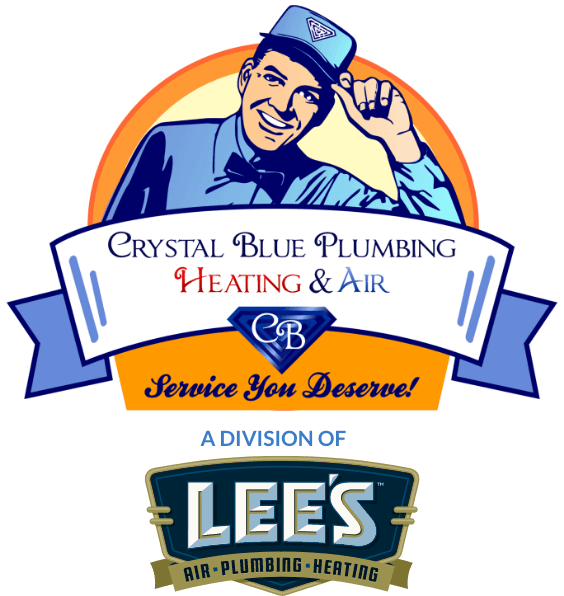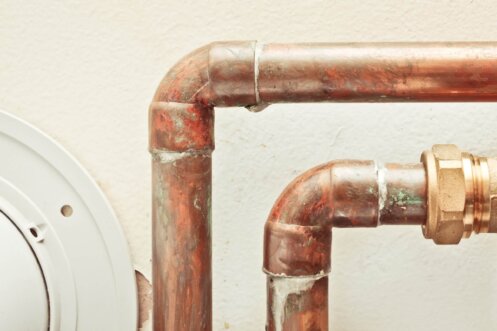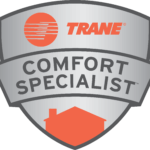Plumbing Red Flags: When Repiping Becomes Necessary
Making sure that you have a healthy plumbing system is important for you as a Sacramento homeowner. Pipes can corrode, leaks can develop, and mineral buildups can create clogs that lead to water damage and decreased water quality. When you understand the warning signs that your plumbing system may need repiping, it can save you time and money.
At Crystal Blue Plumbing, Heating & Air, we help you identify potential problems and provide professional repiping services to make sure that your home’s water system functions safely and efficiently.
Low Water Pressure and Inconsistent Flow
One of the most noticeable signs that your plumbing system may need repiping is consistently low water pressure. If you notice weak water flow in your showers, faucets, or sprinklers despite fully open valves, it could indicate internal corrosion or mineral buildup in the pipes.
Galvanized steel pipes, which are common in homes built before the 1980s, gradually accumulate rust on the interior walls. This reduces the pipe diameter and restricts water flow. Over time, these obstructions can become worse, leaving you with a frustratingly weak water supply. PEX or copper repiping can restore strong, consistent water pressure throughout your home, improving both functionality and comfort.
Discolored or Rusty Water
Discolored water is another major indicator of aging pipes. If your tap water has a yellow, orange, or brown tint, it often points to corrosion inside your pipes. Rust and mineral deposits can leach into the water, leaving stains on sinks, tubs, and laundry.
Corroded galvanized pipes are particularly prone to this problem. Drinking or cooking with discolored water will likely affect its taste, but it could also raise health concerns over long-term exposure to metal contaminants. Repiping with new copper or PEX pipes eliminates the source of rust, delivering clean, clear water throughout your home.
Frequent Leaks or Water Damage
Repeated leaks are a clear warning that your plumbing system is deteriorating. While you can patch small leaks, homes with old pipes may experience multiple leaks in different areas over time. These leaks can appear in visible spots, like under sinks or behind walls, or they may go unnoticed until significant water damage occurs.
Water stains on ceilings, warped flooring, or musty odors can indicate hidden leaks in older plumbing systems. Continuous exposure to moisture damages your home’s structure and can increase the chance of mold growth. A complete repiping of your system will address the root cause of these leaks, preventing future damage and giving you peace of mind.
Strange Noises From Pipes
If your pipes make banging or gurgling noises when you turn on the water or flush a toilet, it may be a sign of failing pipes. Older plumbing systems with rigid steel or iron pipes often transmit water pressure fluctuations more aggressively, creating loud sounds that can be unsettling.
New PEX or copper pipes are more flexible and resistant to corrosion, reducing the likelihood of these noises and helping maintain smoother water flow.
Water Quality Issues
In addition to drinking and cooking, poor water quality can affect your appliances, causing buildup in water heaters, dishwashers, and washing machines. Repiping with modern, safe materials is a great way to make sure that your water remains clean and free from contaminants, protecting your family’s health and your home’s appliances.
Multiple Pipe Repairs
If you’ve already repaired multiple leaks or clogs in your plumbing system, it may be time to consider a full repipe. Frequent repairs indicate that the existing pipes are deteriorating, and patching them may provide only temporary relief.
Older galvanized, polybutylene, or corroded steel pipes are prone to recurring problems. While repairs can address immediate leaks, repiping replaces the root cause of the issues. This will provide a long-term solution that minimizes future disruptions and reduces overall maintenance costs.
Visible Corrosion or Pipe Deterioration
Another obvious sign that your plumbing system may need replacement is visible corrosion on exposed pipes. Rusty, discolored, or flaking pipes indicate that metal is breaking down and could fail at any time.
Even minor corrosion on a small section of pipe often signals that the system as a whole is aging. Replacing old pipes with modern materials will ensure that you won’t experience sudden pipe bursts or leaks in the near future.
Aging Plumbing System
Homes built 40 to 50 years ago, or even more recently, with certain materials, may have reached the end of their plumbing lifespan. Galvanized steel, polybutylene, and even older copper pipes have a finite service life.
Signs of aging include frequent leaks, low pressure, discolored water, and unusual pipe noises. While occasional repairs may extend the life of your system, a full repipe is often the most cost-effective and reliable way to upgrade your plumbing system.
Benefits of Repiping
Investing in a full repipe offers long-term benefits that extend far beyond simply fixing leaks. Here are some ways that upgrading your pipes will improve your plumbing system.
Improved Water Pressure
Repiping immediately restores noticeable water pressure throughout your home. Older or corroded pipes often can restrict water flow, leaving showers weak and faucets slow. Replacing aging pipes with modern PEX or copper materials make sure that you have consistent water pressure throughout your home.
Cleaner, Healthier Water
Repiping delivers cleaner water for your family. Corrosion and mineral buildup in old pipes can introduce rust, sediment, and trace metals into your water supply, affecting taste and safety. Upgrading to new piping that has more durability removes these risks, providing water that is safer to drink and better for cooking, laundry, and bathing.
Increased Reliability and Durability
Modern pipes resist corrosion, scale, and root intrusion, which reduces the risk of sudden pipe bursts or persistent leaks. This means fewer emergency repairs, giving you peace of mind that your plumbing system can handle daily use without constant attention.
Enhanced Efficiency
Unobstructed pipes allow water to flow smoothly, which will reduce the strain on your water heater and other appliances. This improved efficiency can lower energy consumption, minimize wear on your equipment, and even reduce utility bills, making the investment in a full repipe pay off over time.
Protection for Your Home
Repiping protects your home’s structure and finishes. Leaks from old pipes can cause water damage that leads to mold growth. Replacing deteriorating pipes safeguards both your family and your home, preserving its value and avoiding costly repairs in the future.
Increased Home Value
A complete repipe will enhance the resale value of your home. Buyers value a plumbing system that is reliable, and updated pipes will help your home to look cared for with a minimal risk of problems in the future. When your home has modern plumbing, it appears more attractive to potential buyers.
Trust Us to Repipe Your System
Repiping your home may feel like a big investment, but it delivers long-term benefits, such as improved water pressure, cleaner water, and enhanced reliability. Locally owned and operated since 1976, we offer high-quality plumbing services in the Sacramento area, including water heater repair and drain cleaning.
Contact Crystal Blue Plumbing, Heating & Air today to schedule a consultation.








